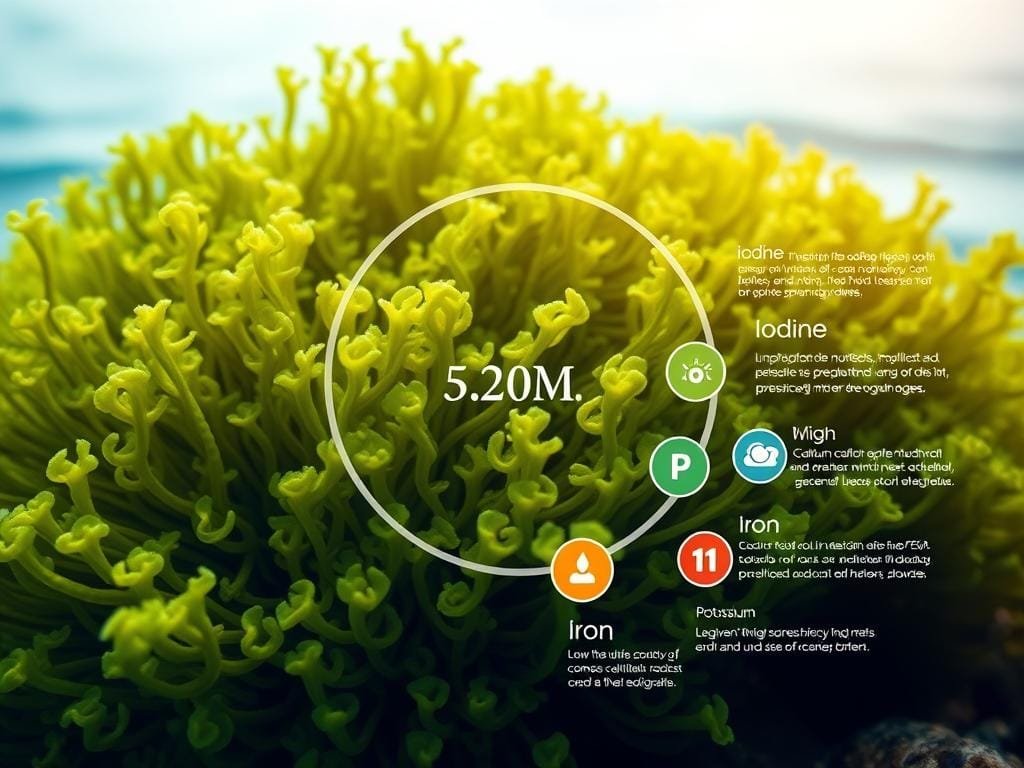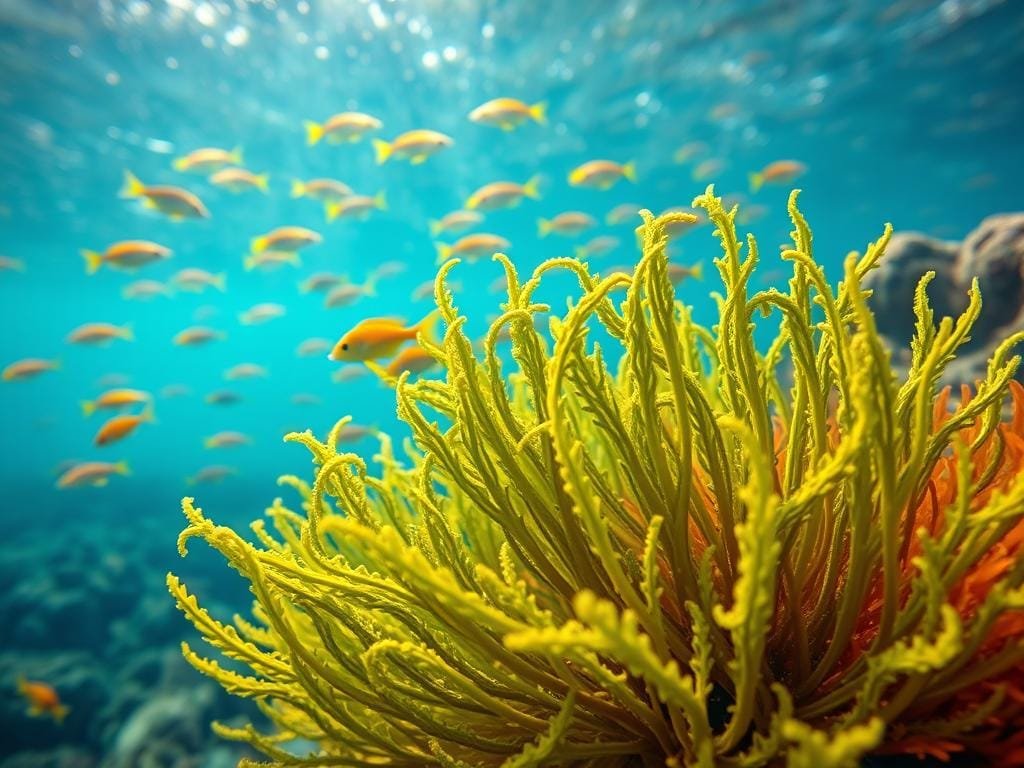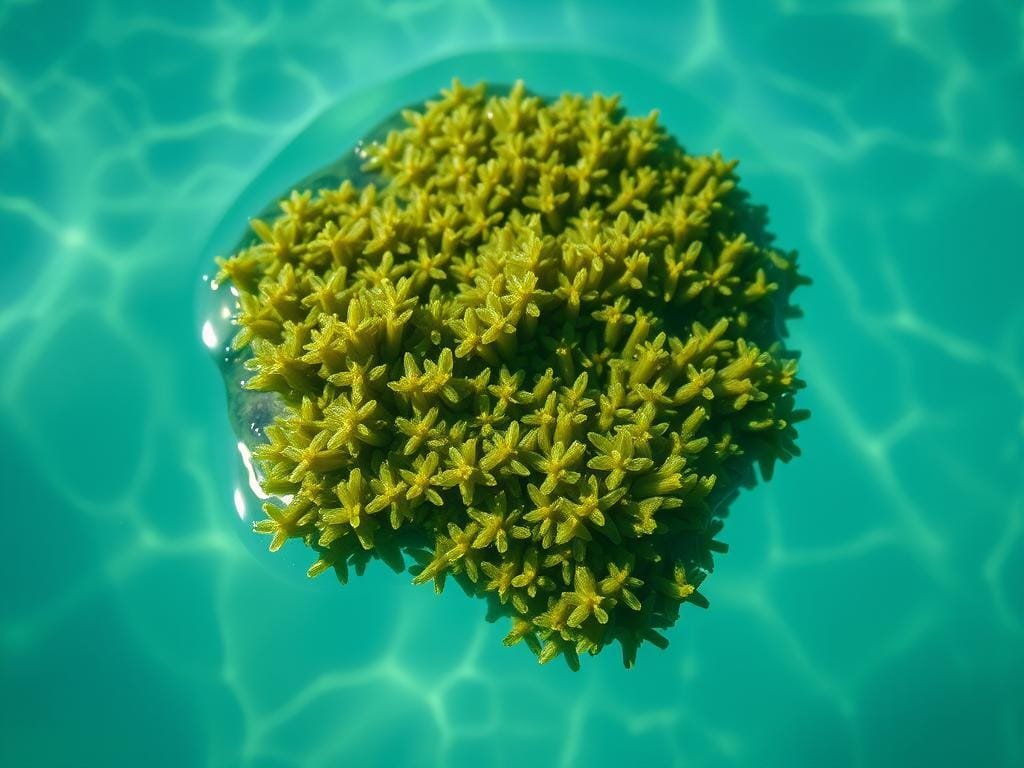Have you heard about sea moss, the new superfood everyone’s talking about? Also known as Irish moss or red seaweed, it’s packed with nutrients. For centuries, it’s been a key part of traditional medicine.
Sea moss is a vegan, gluten-free source of many essential nutrients. It’s rich in Vitamin B2, calcium, magnesium, and zinc. This has made it a favorite among health fans. Now, more people are seeing its benefits.
Exploring sea moss reveals its many advantages. It’s not just good for you; it’s also trendy. Learn about its nutritional value and health perks to see why it’s so popular.
Table of Contents
Key Takeaways
- Sea moss is a rich source of essential nutrients like Vitamin B2, calcium, magnesium, and zinc.
- It’s a vegan and gluten-free superfood.
- Sea moss has been used in traditional medicine for centuries.
- Its nutritional profile makes it a popular choice among health enthusiasts.
- Sea moss is considered a viral superfood due to its potent health benefits.
What Is Sea Moss? Understanding the Marine Superfood
Have you heard of sea moss? It’s a marine algae that can boost your health. Known as Irish moss or Chondrus crispus, it grows on North Atlantic shores. It has a tufted look and comes in colors from greenish-yellow to dark purple.
The Different Types of Sea Moss
Sea moss comes in several types, with Chondrus crispus being well-known. It’s packed with vitamins and minerals, making it a favorite for supplements. Other types may look different and have unique nutritional values.
Irish Moss vs. Other Sea Moss Varieties
Irish moss is often called sea moss, but there are others too. Irish moss is a specific red algae. Other types have different looks and nutritional benefits. For more on sea moss health benefits, check out WebMD.
How Sea Moss Differs from Land Moss
Sea moss grows in the ocean, unlike land moss which grows on land. Sea moss gets its nutrients from the sea, giving it lots of iodine. Land moss has a different set of nutrients. Knowing these differences helps us see why sea moss is special.
The Nutritional Profile of Sea Moss
Sea moss is more than just a marine algae. It’s a powerhouse of nutrition that supports many bodily functions. Adding this nutrient-rich superfood to your diet can greatly improve it.

92 Essential Minerals and Vitamins
Sea moss is packed with minerals like potassium, calcium, magnesium, and zinc. These are key for nerve signals, strong bones, and a healthy immune system. Healthline says sea moss has a wide range of vitamins and minerals for better health.
“Sea moss is a great source of iodine, vital for the thyroid,” experts say. Adding sea moss to your diet helps ensure you get these important nutrients.
Protein and Fiber Content
About one-third of sea moss is carrageenan, a thickening agent when mixed with water. It also has protein and fiber, adding to its nutritional value. Its digestive benefits make it great for meals.
Unique Bioactive Compounds
Sea moss contains bioactive compounds that offer health benefits. These compounds can enhance your overall well-being and support a natural health boost.
In summary, sea moss is a great addition to a healthy diet. Its rich content of minerals, vitamins, protein, and bioactive compounds make it a valuable choice. Understanding its nutritional profile helps you make smart choices for your daily routine.
Health Benefits of Moss as a Superfood
Sea moss offers many health benefits, from boosting your immune system to helping your thyroid. Adding it to your diet can greatly improve your health and wellbeing.

Immune System Support
Sea moss is packed with antioxidants and has anti-inflammatory properties. It’s great for your immune system. It contains beta-carotene and vitamins that fight off infections and diseases. Regularly eating sea moss can make your immune system stronger and lower your risk of getting sick.
Thyroid Function and Iodine
Sea moss is rich in iodine, which is vital for a healthy thyroid. Not enough iodine can cause thyroid problems like hypothyroidism and goiter. Eating sea moss helps you get enough iodine for your thyroid and metabolism.
Digestive Health Improvements
Sea moss has prebiotic fibers that feed the good bacteria in your gut. This improves your digestive health. It can also reduce inflammation and boost your immune system. Its anti-inflammatory properties may help with digestive issues like IBS.
Weight Management Properties
The fiber in sea moss helps with weight management by making you feel full and reducing cravings for junk food. It also supports metabolism and energy, keeping you active and focused.
In summary, sea moss is a great addition to a healthy diet. It supports your immune system, thyroid, and helps with weight management. Adding sea moss to your daily routine can greatly improve your health and wellbeing.
How to Source High-Quality Sea Moss
To get the most out of sea moss, you need to find the best quality. Knowing where to look and how to spot authentic products is key.
Wild-Harvested vs. Pool-Grown
Sea moss comes in two types: wild-harvested and pool-grown. Wild-harvested sea moss is picked from the ocean. It’s better because it gets more minerals from the sea.
Pool-grown sea moss is raised in controlled places. It’s consistent but might not have as many minerals as wild-harvested.

Identifying Authentic Sea Moss
It’s important to buy real sea moss. Look for organic sea moss that’s been tested by a third party. Real sea moss smells like the sea and looks right.
Be careful of cheap products or those without clear labels. They might not be what they seem.
Best Places to Purchase Sea Moss
You can find sea moss in many forms, like capsules, gels, and creams. Try health food stores, specialty shops, and online retailers. Online, make sure to buy from trusted sources with good reviews.
Price Points and What to Expect
Sea moss prices vary by type, quality, and brand. Basic dried sea moss costs between $20 to $50. High-quality, organic sea moss can be $50 to $100 or more. Quality is worth the investment for the best benefits.
Step-by-Step Guide to Preparing Raw Sea Moss
Preparing raw sea moss is easy but needs careful steps to get the most nutrition. You’ll need to follow a few simple steps to turn raw sea moss into gel.
Cleaning and Removing Debris
The first step is to clean the sea moss well. Rinse it under cold water to get rid of debris or salt. Be gentle to avoid breaking the sea moss. Then, check for any leftover debris like shells or sand and take them out by hand.

Proper Soaking Techniques
After cleaning, soak the sea moss. Put it in a big bowl and cover it with cold water. Soak it for at least 24 hours, changing the water a few times to remove impurities. Soaking properly is key to rehydrating the sea moss for blending.
Blending Perfect Sea Moss Gel
After soaking, drain and rinse the sea moss again. Then, blend it with fresh water in a blender. Start with 1 cup of sea moss to 2 cups of water for a good gel consistency. Blend until smooth, stopping and scraping the sides as needed.
Troubleshooting Common Preparation Issues
If you face problems like a grainy texture or bad smell, there are fixes. For a grainy texture, blend longer or add more water. Bad smell means it wasn’t cleaned or soaked right. Start over with a new batch, focusing on cleaning and soaking.
Sea Moss Gel: Storage and Preservation Methods
To keep your sea moss gel fresh, it’s key to know the best ways to store and preserve it. Proper storage keeps the gel’s nutrients and extends its shelf life. This way, you can enjoy its benefits for longer.
Refrigeration Guidelines
Refrigerating your sea moss gel is a simple way to keep it fresh. When stored in an airtight container, it can last up to two weeks. It’s important to seal the container tightly to prevent contamination and spoilage.
Freezing Sea Moss Gel in Ice Cube Trays
Freezing sea moss gel in ice cube trays is a great option for longer storage. This method lets you use the gel in convenient portions. Just pour the gel into the trays, freeze, and then store the frozen cubes in a bag or container. Frozen gel can last for months.
Signs Your Sea Moss Gel Has Gone Bad
It’s important to check your stored sea moss gel regularly for signs of spoilage. If you notice an off smell, a slimy texture, or mold, it’s time to throw it away. These signs mean the gel has gone bad and is not safe to eat.
Extending Shelf Life Naturally
To naturally extend your sea moss gel’s shelf life, add a bit of lemon juice or vitamin C. These can help keep the gel fresh by stopping bacteria and mold growth. Also, always use clean utensils when handling the gel to avoid contamination.
- Store in airtight containers to prevent air exposure.
- Keep the gel away from strong-smelling foods, as it can absorb odors.
- Label containers with the date to keep track of storage time.
10 Ways to Incorporate Sea Moss Into Your Daily Diet
Sea moss is a superfood that can be used in many dishes. It’s great for adding vitamins, minerals, and antioxidants to your meals. This makes it a fantastic addition to your daily diet.
Morning Smoothie Recipes
Starting your day with a sea moss smoothie is energizing and nourishing. Mix sea moss gel with fruits like bananas or berries. Add almond milk or coconut water for a refreshing drink.
- Sea Moss Berry Bliss: Blend 1 tablespoon of sea moss gel with 1 cup of mixed berries, 1/2 banana, and 1/2 cup of almond milk.
- Tropical Green Smoothie: Mix 1 tablespoon of sea moss gel with 1 cup of spinach, 1/2 cup of pineapple, 1/2 cup of coconut water, and a squeeze of fresh lime juice.
Sea Moss in Hot Beverages
Sea moss can be added to hot drinks for extra nutrition. Stir a spoonful of sea moss gel into your morning coffee or tea. It adds a creamy texture and a hint of ocean flavor.
Try a Sea Moss Hot Chocolate for a comforting drink. Blend 1 tablespoon of sea moss gel with 1 cup of hot milk, 1 tablespoon of cocoa powder, and a touch of honey or maple syrup for sweetness.
Using Sea Moss as a Cooking Thickener
Sea moss gel is a natural thickener for soups, stews, and sauces. Just stir it into your dish as it cooks to get the right consistency.
Sea Moss Desserts and Sweet Treats
Sea moss can even be used in desserts! Its neutral flavor is perfect for puddings, custards, and other sweet treats. Make a Sea Moss Panna Cotta by mixing 1/2 cup of sea moss gel with 1 cup of cream, 2 tablespoons of sugar, and a vanilla bean. Pour into cups and refrigerate until set.
Using sea moss in cooking and baking adds nutrition and creativity to your recipes. It’s great for both hearty stews and sweet desserts. Sea moss is a valuable ingredient to have in your pantry.
DIY Sea Moss Skincare Applications
Sea moss can change your skincare routine. It moisturizes and fights inflammation. It’s great for making your own skincare products.
Facial Mask Recipes and Application
Make a softening facial mask with sea moss. Mix it with honey and yogurt for a refreshing treat.
- Mix 2 tablespoons of sea moss gel with 1 tablespoon of honey and 1 tablespoon of yogurt.
- Apply the mask to your face and leave it on for 15-20 minutes.
- Rinse with warm water and pat dry.
Sea Moss Hair Treatments
Sea moss is good for your hair too. It nourishes and moisturizes your scalp, helping your hair grow.
To make a sea moss hair treatment, blend sea moss gel with coconut oil and essential oils like lavender or peppermint.
| Ingredient | Quantity |
|---|---|
| Sea Moss Gel | 1/4 cup |
| Coconut Oil | 2 tablespoons |
| Essential Oil | 5 drops |
Body Scrubs and Moisturizers
Sea moss makes a great body scrub. It exfoliates and moisturizes your skin. Mix it with sugar or salt and coconut oil.
Benefits of Sea Moss Body Scrub: Exfoliates dead skin cells, moisturizes, and nourishes the skin.
Potential Side Effects and Precautions
Thinking about adding sea moss to your diet? It’s good to know about possible risks. Sea moss is usually safe, but there are some things to watch out for to eat it safely.
Iodine Sensitivity Concerns
Sea moss has a lot of iodine, which is important for the thyroid. But too much iodine can cause thyroid problems. If you have a thyroid issue or are sensitive to iodine, watch how much you eat.
Symptoms of iodine sensitivity may include:
- Thyroid gland inflammation
- Thyroid nodules
- Changes in heart rate
Medication Interactions
Sea moss might affect some medicines, like those for the thyroid or blood thinners. If you’re on warfarin or thyroid hormone meds, talk to your doctor before trying sea moss.
| Medication Type | Potential Interaction |
|---|---|
| Blood Thinners | Increased risk of bleeding |
| Thyroid Medications | Altered thyroid hormone levels |
Recommended Dosage Guidelines
There’s no one-size-fits-all dose for sea moss. Start with 1-2 tablespoons of sea moss gel a day. Then, you can slowly add more if you need to, with your doctor’s advice.
When to Consult a Healthcare Provider
Thinking about adding sea moss to your diet? If you have health issues or take meds, see a doctor first. They can give you advice that fits your health needs.
It’s always better to err on the side of caution when introducing new supplements into your routine.
Conclusion: Making Sea Moss a Sustainable Part of Your Wellness Routine
Adding sea moss to your daily routine can boost your wellness and support green living. It’s key to use it in moderation and know its side effects. This way, you get its health benefits without harming your lifestyle.
Starting a moss garden or looking into moss landscaping is a great way to connect with nature. It lets you see the beauty of sea moss up close. Remember to buy sea moss from eco-friendly sources to help the planet.
Using sea moss wisely can improve your health and the environment. As you keep moving forward on your wellness journey, think about how sea moss can positively affect you and the planet.

